- Sources of information :
- Sources of information :
Video:
https://www.youtube.com/watch?v=opKbELbJEQQ&list=PL9NYvjxBy6SOxm8UjvbqXmpBDsvJLDClw&index=2
- Name of sport (game): Garrote
- Name in native language: Garrote or Lucha del Garrote
- Place of practice (continent, state, nation):
Canary Islands
- History:
El Garrote is a stick made of wood, which can have various sizes and thicknesses, and was a tool used by the aboriginal shepherd, on a daily basis, not only for handling livestock, the main economic activity of the time, but to defend himself of aggressions between different clans or groups that vied for pasture and other issues.
The island terrain forced the Aboriginal shepherd to use the club, since he needed it to speed up his movements, in search of pasture for livestock.
The Canarian shepherd (El Patsor canario) traveled alone, with his cattle, through various island sites, where unlike there was currently no settlement, or communication channels, so that on many occasions security could be compromised by the dangerous terrain, in turn. the shepherd had to make forays with his cattle in unknown territories in search of new pastures, so it could be the case that there were other groups using the area, leading to clashes.
The pastor, due to his isolation and his sacrificed spirit, conferred a strong and strong character, developing a physical and mental resistance that the inhabitants located in settlements did not possess.The clashes between shepherds are defined through the Lucha del Garrote with the strongest and most skilled being the winner; in this way we can speak of a shepherd - warrior, that is, a person who cares for his cattle and at the same time has the ability to give an immediate response to an aggression or invasion of his territory.
After the Conquest, the aboriginal shepherd maintains his cattle activity conserving his main tool, to which a fundamental change is introduced: the iron puyón or regatón in one of its ends in order to be used as a support point.
The shepherd, given his isolation, had a reserved character, being the contacts with the settlers very punctual, but a symbiotic relationship is established since the shepherd needs some objects or food and the settlers know that the shepherd is the best connoisseur of the sidewalks and pastures for cattle, in addition to being a good supplier of meat, cheese, milk and leather.
The shepherd's isolation makes the use of the stick and club stick, unlike other customs that were lost until his recent recovery.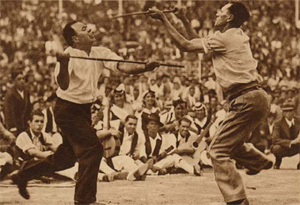
- Description:
The technique of the club fight depends on two factors:
On the one hand, it depends on the type of stick that is used, since the size and type of wood with which the piece is made are factors to consider. And on the other hand, we have the technique, which is acquired depending on the school where the wrestler has been trained.The game consists of giving without being reached, for this, you have to use both hands, using body parts, hooks, etc.
The player or fighter must have great speed with the feet, skill with the arms and many reflexes.
The sticks can receive a wide variety of names depending on the Island or the place: Palo, Garrote, Lata, Asta, Astia, Vara, Lanza, Regatón, Vera, etc.
Regarding the classification of the clubs, the following differentiation has been reached:
Palo largo or grande: it is the largest of all, preferably used by shepherds, and can have various measures, although one of the shepherd's size is used to play. As for thickness, they are usually of a homogeneous diameter that fits the hands. This type of stick, being larger and thicker, gives more forceful blows. It is usually grasped by the center and the ends are used to hit.
They receive a great variety of names depending on the island or the place: Palo, Garrote, Lata, Asta, Astia, Vara, Lanza, Regatón, Vera, etc.Palo medio: of this type there is a great variety of measures, although generally it extends from the ground to the heart. As for thickness, they are usually thicker at one end than at the other.
This stick can be grasped by either end, although it is generally held by the thickest part.
This stick is usually used, normally, in the technique called "collecting", which is mainly based on defensive techniques.Palo corto or Macana: it is a very effective and dangerous tool, if you know how to use it it can cause great damage to your opponent. To use it requires great skill with your hands and arms.
Very fast footwork is also required. Sometimes it was the case that the fighter had been or was a dancer himself.
The sticks can receive a wide variety of names depending on the Island or the place: Palo, Garrote, Lata, Asta, Astia, Vara, Lanza, Regatón, Vera, etc.
The materials with which these instruments were made used to be the woods obtained from fruit and endemic trees, typical of the Canary Islands. In the Eastern Islands, Lanzarote and Fuerteventura, the wood had to be imported from other places due to the lack of good woods for the manufacture of quality clubs. The choice and cutting of wood is part of an ancient ritual, which depends on the phases of the moon; straightens with fire.
The types of trees most used for this purpose are:
- Fruit trees: Quince tree (Cydonia Oblonga), Almond tree (Prunus Amygdalus), Plum tree (Prunus domesticus).
- Endemic Trees: Palm (Phoenix canariensis), Barbusano (Apollonias barbujana), Palo Blanco (Picconia excelsa), Acebuche (Olea europaea), Canary Island Pine (Pinus canariensis). - Current status:
The National Days of the Traditional Garrote Game to be held in October 2022 in Telde, Gran Canaria, aim to present the results of different investigations in fields as varied as physical activity and sports, archaeology, history and ethnography, in addition to dignifying the practice and returning prominence to its true rescuers, the shepherds of Gran Canaria.
- Sources of information :
Books:
GONZÁLEZ, A., y MARTÍNEZ, G., El Juego del Palo Canario. Centro de Cultura Popular Canaria. Santa Cruz de Tenerife,1992
Articles:
https://www3.gobiernodecanarias.org/medusa/wiki/index.php?title=Lucha_del_garrote&fbclid=IwAR0sujCv5khpUt6ia3L4HBCPZ_ODBbN6UmF0tMQq8L7IpIvilU-2pudt2N8
https://elrincondelaikido.blogspot.com/2014/12/juego-del-garrote-canario.html?fbclid=IwAR3Tdr8RLOlS67JF9aaJ7p05vUvyRMCncnRwNadeMAY6EoLy6xXxvLW9iqYVideo:
https://www.youtube.com/watch?v=n-6UaT9qlXk&fbclid=IwAR1j9mjMa0phJsW352q_L7EMf8JSpEI2Z_x77-LbRwEdyjDszghgj27lvg8
https://www.youtube.com/watch?v=SSPl7P2y-aI&fbclid=IwAR1_R3aaMPWZP3fOvkvQlkTpx3h-g97PYWq960J5vj3pxuj2OJvog6aknGo - Gallery:
- Name of sport (game): Glima
- Name in native language: Glima
- Place of practice (continent, state, nation):
Iceland
- Description:
Glima is played on grass outdoor and or a wooden floor indoor.
It is a standing up wrestling style with clothes. Wrestlers (men or women) wear specific clothes and a leather harness at the belt. This harness was introduced in 1905. Wrestlers start by gripping the harness with the hands. They are not allowed to lose this hold.
There are several weight and age categories. Techniques are done mainly with legs.The goal is to throw the opponent on any part of the body, from knees to the shoulders.
- Name of sport (game): Goose pulling (also called gander pulling, goose riding, pulling the goose or goose neck tearing)
- Name in native language: Ganstrekken in the Netherlands, Gansrijden in Belgium, Gänsereiten in Germany
- Place of practice (continent, state, nation):
Netherlands, Belgium, Germany
- History:
Goose pulling (also called gander pulling, goose riding, pulling the goose or goose neck tearing) was a blood sport practiced in parts of the Netherlands, Belgium, England, and North America from the 17th to the 19th centuries. It originated in the 12th century in Spain and was spread around Europe by the Spanish Third.
In El Carpio de Tajo (Spain) goose pulling is practised on every July 25th to celebrate the liberation (Reconquista) from the Arabs in 1141. Later, during the dictatorship of Franco, the use of live geese was prohibited by a new animal protection law. Instead of geese, ribbons tied to sticks were used, which the riders had to insert into metal rings. When democracy returned to Spain, the use of geese was again allowed.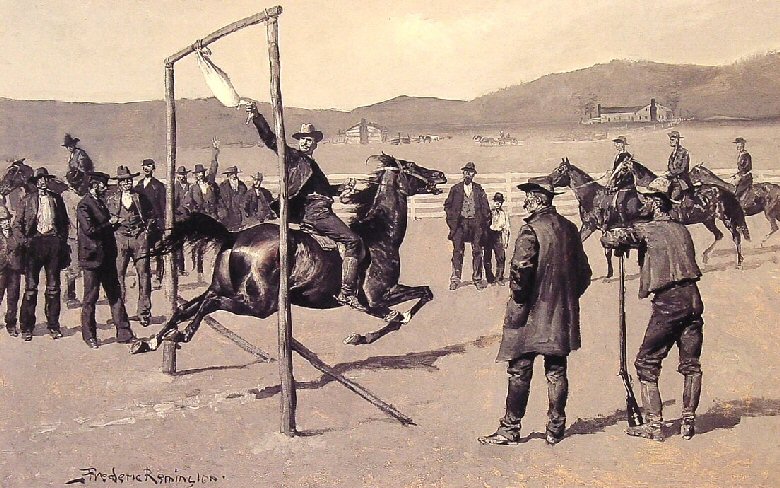
Goose pulling in 19th-century West Virginia, as depicted by Frederic Remington (source:https://www.wikiwand.com/en/Goose_pulling#/overview)Goose pulling is attested in the Netherlands as early as the start of the 17th century; the poet Gerbrand Adriaensz Bredero referred to it in his 1622 poem Boerengeselschap ("Company of Peasants"), describing how a party of peasants going to a goose-pulling contest near Amsterdam end up in a brutal brawl, leading to the lesson that it is best for townspeople to stay away from peasant pleasures.
Although the use of live geese was banned in the Netherlands in the 1920s, the practice still arouses some controversy. In 2008 the Dutch Party for Animals (PvdD) proposed that it should be banned; the organisers, Folk Verein Gawstrèkkers Beeg, rejected the proposal, pointing out that there was no question of cruelty to animals because the geese were already dead.Belgian goose pulling is accompanied by an elaborate set of customs. The rider who succeeds in pulling off the goose's head is "crowned" as the "king" for one year and given a crown and mantle. At the end of his "king year" the ruling king has to treat his "subjects" to a feast of beer, drinks, cigars and bread pudding or sausages held either at his home or at a local pub. The kings compete with each other to become the "emperor". Children participate as well; in 2008, the children's goose pulling tournament in Lillo near Antwerp was won by a 14-year-old who won 390 euros and a trip to the Plopsaland theme park.
In Wattenscheid (Germany) it is believed that the custom was brought by Spanish soldiers who were stationed in 1598 and 1599 during the Eighty Years' War and later in the Thirty Years' War. In some other places of Germany it was forbidden.
The sport appears to have been relatively uncommon in Britain, as all references are to it as a curiosity practiced somewhere else. The 1771 Philip Parsons locates it in "Northern parts of England" and assumes it is unknown in Newmarket in Southern England.
In a satirical letter to Punch in 1845 it is regarded as a barbarous practice known only to the bloodthirsty Spaniards, like bull-fighting.
The serious work Observations on the popular antiquities of Great Britain, of 1849, calls it "Goose-riding" and says it has been "practiced in Derbyshire within the memory of persons now living", and that the antiquary Francis Douce (1757–1834) had a friend who remembered it "when young" in Edinburgh in Scotland.
From these references it would appear to have died out in Britain by the end of the 18th century.The Dutch settlers of North America brought it to their colony of New Netherland and from there it was transmitted to English-speaking Americans. Goose-pulling was taken up by those at the lower levels in American society,[3] though it could attract the interest of all social strata. In the pre-Civil War South, slaves and whites competed alongside each other in goose-pulling contests watched by "all who walk in the fashionable circles."[13] Charles Grandison Parsons described the course of one such contest held in Milledgeville, Georgia in the 1850s (Parsons, Charles Grandison (1855). Inside view of slavery: or A tour among the planters. John P. Jewett and Co. pp. 136–7).
The prizes of a goose-pulling contest were trivial – often the dead bird itself, other times contributions from the audience or rounds of drinks. The main draw of such contests for the spectators was the betting on the competitors, sometimes for money or more often for alcoholic drinks. One contemporary observer commented that "the whoopin', and hollerin', and screamin', and bettin', and excitement, beats all; there ain't hardly no sport equal to it." Goose-pulling contests were often held on Shrove Tuesday and Easter Monday, with competitors "engaged in this sport not just for its excitement but also to prove they were "real men," physically strong, brave, competitive and willing to take risks."
Unlike some other contemporary blood sports, goose pulling was often frowned upon. In New Amsterdam (modern New York) in 1656, Director General Pieter Stuyvesant issued ordinances against goose pulling, calling it "unprofitable, heathenish and pernicious." Many contemporary writers professed disgust at the sport; an anonymous reviewer in the Southern Literary Messenger, writing in 1836, described goose pulling as "a piece of unprincipled barbarity not infrequently practised in the South and West." William Gilmore Simms described it as "one of those sports which a cunning devil has contrived to gratify a human beast. It appeals to his skill, his agility, and strength; and is therefore in some degree grateful to his pride; but, as it exercises these qualities at the expense of his humanity, it is only a medium by which his better qualities are employed as agents for his worser nature." (Simms, William Gilmore (1852). As good as a comedy: or, The Tennesseean's story. A. Hart. p. 115.)
The sport was challenging, as the oiling of the goose's neck made it difficult to retain a grip on it, and the bird's flailing made it difficult to target in the first place. Sometimes the organisers would add an extra element of difficulty; one writer describing an event in the American South witnessed "a [man], with a long whip in hand ... stationed on a stump, about two rods [10 m / 32 ft] from the gander, with orders to strike the horse of the puller as he passed by." The reaction of the startled horse would make it even more difficult for the puller to grab the goose as he went by.
Goose-pulling largely died out in the United States after the Civil War, though it was still occasionally practised in parts of the South as late as the 1870s; a local newspaper in Osceola, Arkansas reported of an 1870s picnic that "after eats, gander-pulling was engaged in. Mr. W.P. Hale succeeded in pulling in twain the gander's breathing apparatus, after which dancing was resumed."A variant called "rooster pulling" has survived in New Mexico for some time. A rooster was buried in the sand up to its neck, and riders would try to pull it up as they rode past. This was later done with bottles buried in the sand.
- Description:
The sport involved fastening a live goose with a well-greased head to a rope or pole that was stretched across a road. A man riding on horseback at a full gallop would attempt to grab the bird by the neck in order to pull the head off. Sometimes a live hare was substituted.
- Current status:
It is still practiced today, using a dead goose, in parts of Belgium and in Grevenbicht in the Netherlands as part of Shrove Tuesday and in some towns in Germany as part of the Shrove Monday celebrations. It is referred to as Ganstrekken in the Netherlands, Gansrijden in Belgium and Gänsereiten in Germany using a dead goose that has been humanely killed by a veterinarian.
- Sources of information :
Edward Brooke-Hitching. Fox Tossing, Octopus Wrestling, and Other Forgotten Sports, Simon and Schuster, 2015
John Brand, Sir Henry Ellis, Halliwell-Phillipps, James Orchard (1849). Observations on the popular antiquities of Great Britain: chiefly illustrating the origin of our vulgar and provincial customs, ceremonies, and superstitions, Volume 2. London: Bohn, 1849
Elizabeth Hafkin Pleck, Celebrating the family: ethnicity, consumer culture, and family rituals. Harvard University Press, 2000Video:
https://www.youtube.com/watch?v=heZVmRXSP9s
https://www.thesun.co.uk/news/4104903/goose-pulling-tradition-video/ - Gallery:
- Name of sport (game): Gouren
- Name in native language: Gouren
- Place of practice (continent, state, nation):
France (Brittany)
- History:
Gouren became a popular sport in the Middle Ages. It was mainly practised by peasants, even if some priests also practised it. Breton lords learned it and also had some champions who fought for them. During festivals the nobles could fight each other using their champions, it was sometimes a way to solve conflicts.
With the French revolution of 1789, gouren lost its notoriety. The lords could no longer organise festivals and the churchmen participated in the loss of notoriety. Speeches banished gouren and its use: "...all those who go to the fights of St Kadou will be nothing but thieves, debauched and rascals who will roast in hell...". (said in 1831). Gouren survives however thanks to peasants in some regions of Brittany. The sport then became a peasant game.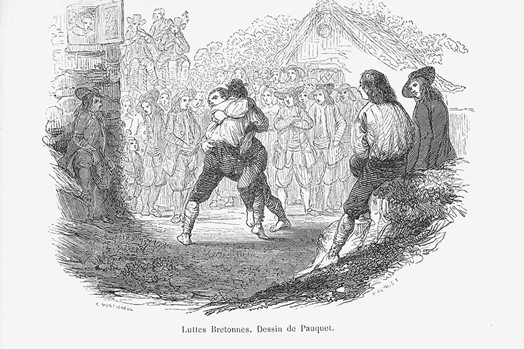
In the 19th century, several writers described gouren tournaments, and several drawings and paintings were also produced, showing the sport in all its different forms. The tournaments organised by the festival committees were meeting places for wrestlers. Wrestlers fought for honour, challenge, pleasure and the prestige of being the strongest man, but the prizes for the winners could be considerable: sometimes a simple handkerchief or a hat, but also a sheep, a bull or a sum of money.
With the First World War in 1914 many Bretons, and therefore wrestlers, died in the war. In addition, the cities became attractive, thus emptying the countryside, which had the effect of weakening this traditional sport.In 1930 Doctor Charles Cotonnec decided to create an organisation called FALSAB (Federation of Friends of Breton Wrestling and Athletic Sports) which would establish a set of rules. Each fight will be supervised by 3 referees and the fight will have a limited duration, depending on the age. Weight and age categories are also created. Other results than the "Lamm (perfect fall on both shoulder blades, ending the fight) were also created: the "Kostin" (fall on one shoulder blade) and the "Kein" (fall on the lower back), which made it possible to decide a winner at the end of a fight.
After that, the federation of gouren was finally created in 1980, it also allows to train wrestlers, referees and competition managers. With this, gouren also opened up to women. Since then, departmental, regional and European championships take place every year, as well as championships during summer festivals.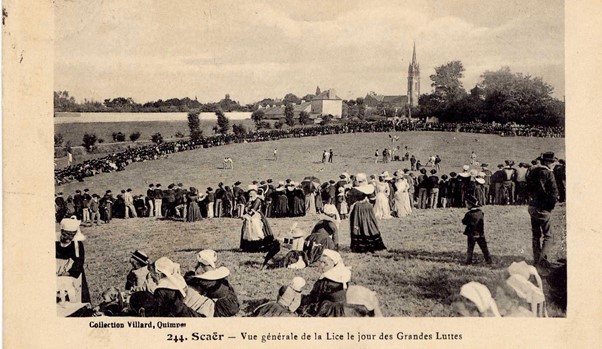
- Description:
During the competitions, each wrestler will first weigh himself in his wrestling clothes. This is to check the outfit and whether the fingernails are cut short. Once all the wrestlers have been weighed, they are called to take the "wrestlers' oath". Wrestlers are called by category and placed to face each other. When everyone has been called the referee table says: "Prest Oc'h" which means "are you ready", the wrestlers then raise their right hand.
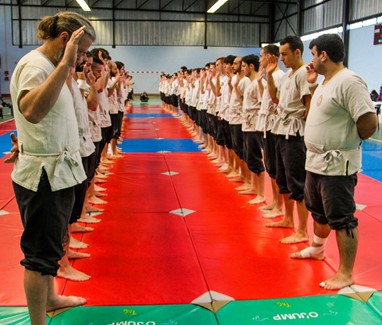
The oath of the wrestlers is then recited:
M’hen tou da c’houren gant lealded - I swear to fight in all loyalty
Hep trubarderez na taol fall ebet - Without treachery and without brutality
Evit ma enor ha hini ma bro - For my honour and that of my country
E testeni eus ma gwiriegez - As a testimony of my sincerity
Hag evit heul kiz vad ma zud koz - And to follow the custom of my ancestors
Kinnig a ran d’am c’henvreur ma dorn ha ma jod - I offer my hand and cheek to my opponentOnce the oath has been recited in French and Breton, the wrestlers will make "l'accolade" (which is an embrace) to the wrestler in front of them. The embrace is characterised by a handshake with the right hand, the left hand on the shoulder and the wrestlers kiss each other's cheek three times. After the oath all wrestlers can do what they want and will wait in different manners to be called to wrestle. Many will chat with other wrestlers (not necessarily from the same club), but also go and encourage their team members during the matches, or warm up before wrestling.
Once called to wrestle, one wrestler is given a red "Ruz" ankle bracelet and the other a green "Gwer" one. The three referees present check that all participants are ready, they also check that the wrestlers' belts are tightened, which has an influence on the fight. The three referees have three different roles:
● One referee will be the timekeeper, he will stop the clock when necessary
● One referee will be responsible for summarising the results
● One referee will sit at a table and record the wrestlers' scores and hand the score sheet to the main table that will announce the resultsThe three referees, although they have different roles, have equal decision-making power. They are also spread in a triangle across the mat in order to have an optimal visibility of the falls.
After the final checks, the Gouren combat will begin. After the summary referee says "Prest Oc'h" the wrestlers repeat the "accolade" to show that they are going to wrestle under the oath recited earlier. Once done, the referee says "Krogit" which means "You may Wrestle".The fight then begins, the goal being to bring down the opponent on both shoulder blades before any other part of the body. This result corresponds to the "Lamm", it is the perfect result and putting it directly ends the fight. Other results also exist in order to differentiate the wrestlers at the end of the fight: "Kostin" which is equivalent to a fall on one shoulder blade, "Kein" is equivalent to a fall on the lower back, "Netra" is equivalent to a fall giving no result.
At the end of a fight, the number of points that are given to a wrestler depends on the result of his technique. If the wrestler wins by Diviz (when there is no result) or by Kein he will gain 3 points, by Kostin 4 points, and by Lamm 6 points.
Each result in the fight has a specific rank.Therefore, one must put the same result to equalize or one must make a higher one to win. For example:
● The wrestler Gwer starts with a Kein, after which the wrestler Ruz puts a Kostin. If the match ends with these results the Ruz wrestler wins by Kostin.
● The wrestler Gwer starts the match and puts a Kein, after which the wrestler Ruz puts a Kostin. Wrestler Gwer finally puts a Kostin at the end of the time. The two Kostin cancel each other out, so Gwer wins by Kein.
● The wrestler Ruz gives 4 Kostin to the wrestler Gwer. Before the extra time, the wrestler Gwer puts on a Lamm. The match ends and the wrestler Gwer wins by Lamm.There is also an extra time called "Astenn" which is given when at the end of the regular time there has been no Kostin or Lamm. It is composed of half of the regulation time. Male adult fighters must therefore fight for 5 minutes + 2:30 minutes of overtime if there is no result. Female adult fighters must wrestle 4 minutes+ 2 minutes of overtime. There is a 30 second break before the overtime. This allows the wrestlers to drink a little and briefly talk to their coach who advises them on their wrestling or on the weaknesses of their opponents.
There are also penalties that can be added to this. If the wrestler deliberately falls down to avoid getting a result, or if he prevents his opponent from wrestling, he may be given a "Diwall" which means "warning". This Diwall does not give any points but if a second Diwall is given it becomes a "Fazi" which means a fault. A player who has taken a Fazi must at least put a Kostin to beat his opponent.
The Fazi can also be obtained if the wrestler tries to put his arm on the ground (which would influence the result but could also injure him) or if he insults or contests the referees' decision. When a wrestler has two fazi, it becomes a Poent ( which is equivalent to a Kostin, except in the case of a perfect tie between the two wrestlers where it is superior). And if the wrestler takes a third Fazi, it becomes a "Fazi Bras" translated by "Serious Fault" which excludes the wrestler from the fight.
Finally, if at the end of the match neither wrestler has made a result (Kein, Kostin, Lamm) there is a Diviz. The Diviz is a result that is decided by the referees. They decide among themselves which wrestler deserves to win. The choice is made if:
● One of the two wrestlers has attacked more than the other.
● One of the two wrestlers has committed a Diwall.
● One of the two wrestlers had a fall that was closest to a result.If neither wrestler can be separated, the "Kouezh" is set up. The goal is to make a hold that takes the opponent to the back. If the opponent falls on his buttocks but rolls onto his back, he has lost.
- Current status:
Gouren’s sports season is spread over two periods: the winter season, from November to May, includes training courses and approximately thirty indoor competitions on "pallennoù" (mats), and the summer season, from June to August, includes tournaments and outdoor exhibitions, generally on the traditional sawdust track, every weekend and often during festivals.
In 2020, the Gouren Federation had 1521 wrestlers, 28% of them being women. They are training in the 45 different schools called “Skol” (meaning schools in Breton) throughout Brittany.
Between its different components the federation hires 9 employees constantly, 7 of which being gouren teachers. In 2019, 10,000 people had been initiated to Gouren. - Contacts:
Fédération de Gouren
10, rue Saint Ernel
29800 Landerneau
Tel. 02 98 85 40 48
E-mail:This email address is being protected from spambots. You need JavaScript enabled to view it.
Website: https://www.gouren.bzh/
Facebook: https://www.facebook.com/federationdegouren/
Instagram: https://www.instagram.com/federationdegouren/
Twitter: https://twitter.com/fedegouren?lang=fr
Youtube: https://www.youtube.com/channel/UCOOPeT25DJ91F76UCN1jdAA/featured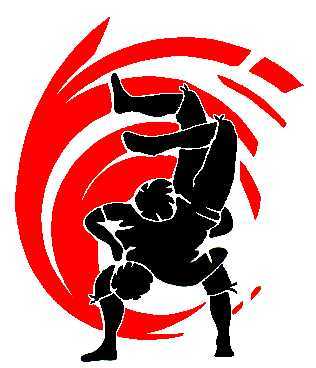
- Sources of information :
Books:
Articles:
Video:
Technique de base:
https://www.youtube.com/watch?v=KukXEwgvtrU
https://www.youtube.com/watch?v=3lBW4lpFP4w
https://www.youtube.com/watch?v=AxqghYREpew
https://www.youtube.com/watch?v=xIOKCUs5pAM
https://www.youtube.com/watch?v=byCQ97b9P_M
https://www.youtube.com/watch?v=6jfTrC8trhw
https://www.youtube.com/watch?v=AvGbIJV9ZV0
https://www.youtube.com/watch?v=r02sCa8MUoE
https://www.youtube.com/watch?v=K1tlFbjC3ZE
https://www.youtube.com/watch?v=FeepLmucZ1k
https://www.youtube.com/watch?v=dQHR8Lrrq7s
https://www.youtube.com/watch?v=KF9FxAuCDUo
https://www.youtube.com/watch?v=50sjzFcoEbgThe information contained in the article comes from the following sources:
https://www.gouren.bzh/Source of photos used in this article and gallery:
https://www.gouren.bzh/Pictures taken by Jean Paul Menou
- Gallery:



